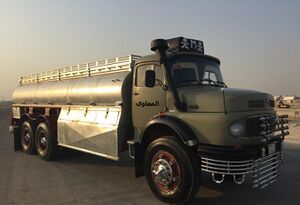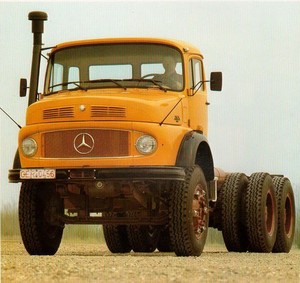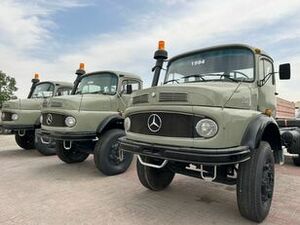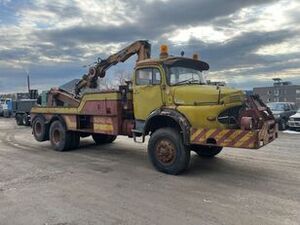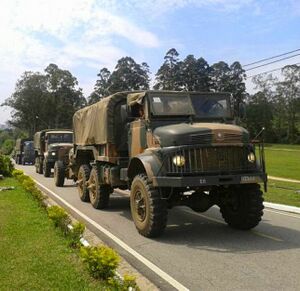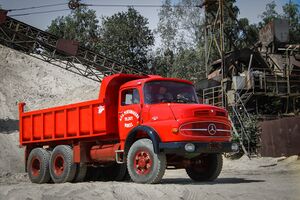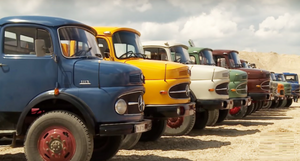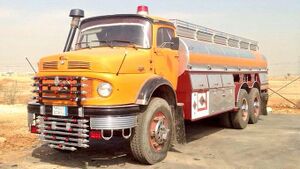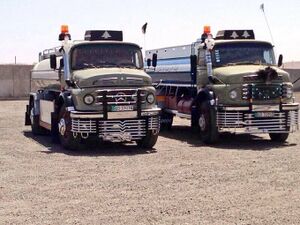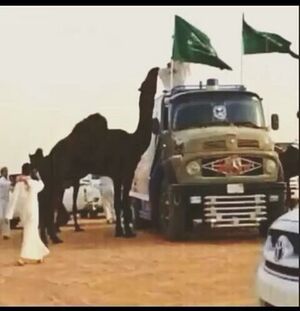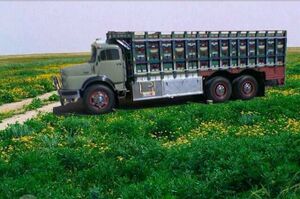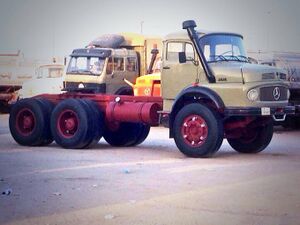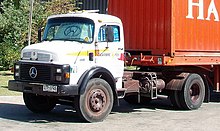شاحنات مرسيدس-بنز قصيرة الكبوت
| Mercedes-Benz Kurzhauber | |
|---|---|
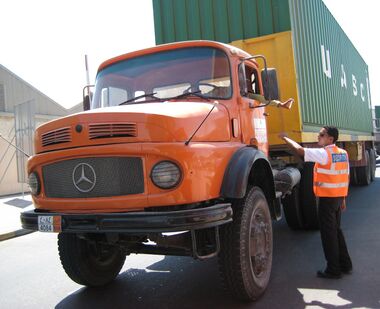 | |
| Overview | |
| المُصنع | Daimler-Benz (1959-1995) Freightliner (1975-1991) Iran Khodro Diesel Company (1979-2022) |
| الجسم والشاسيه | |
| الفئة | شاحنة |
| الشكل الخارجي | FR layout |
| تأريخ | |
| تبعها | Mercedes-Benz NG |
The Mercedes-Benz "Kurzhauber" (short hood) truck is a traditional design, cab-behind-engine truck manufactured from 1959 to the present day (2023). It is indicated[1]
In Germany it is commonly used as Kurzhauser (for "hood")[1] and is referred to briefly in the Arab region by names including Al-Boz, Al-Juffali, Al-Aidi, Al-Saqsas, Al-Aftas, and Al-Afans.
التصميم
(Engine compartment) Much of the cabin space was taken up under the windshield, and this new design was a truck with a narrow front due to German length regulations. The company has successfully overcome many diseases and continues to provide service in many of the regions to which it has been exported.
التاريخ
The first short-bonnet truck model, the Mercedes-Benz L 337, was first produced in Germany in 1959. Its technical successors were in production for export until 1995, long after local German sales had ended. The short hood truck has achieved great export success for Mercedes Benz and has become very popular in the Middle East, Asia Pacific, etc. Africa and South America[2]
Originally, the medium-weight trucks (L323 and L327, with PS100 or 74 kW six diesel engines) were intended for shorter trips. Delivery and construction work was carried out at Daimler-Benz' Mannheim plant. Heavy trucks for long distances and heavy construction work were manufactured at the Gagenau plant.[2] Designated L 337 and L332B (L334B from 1960), 12 t (26,500 lb) or gross weights of 19 t (41,900 lb) and 172–180 hp (127–132 kW) six-cylinder diesels. In 1962, the more powerful 19-ton L334C was added, intended mainly for export. Many model designations were combinations of letters reflecting the vehicle's intended use, until a new system (still in use today) was introduced in the summer of 1963 to include gross weight and engine power.[3][3]
The 5.7 L (5,675 cc) OM352 was Mercedes-Benz's first direct injection diesel engine. After its debut in 1964, the 130 PS (96 kW) Kurzhauber was installed in the L/LP 1113 B series of 1967 (“11” for load “13” reflecting dozens of horsepower). The engine (and other versions of it) is gradually spreading across the range, replacing the previous indirect injection units.[4][4]
Just as the Dodge Power Wagon became synonymous with Aramco exploration throughout Saudi Arabia in the 1950s, short-hood trucks, along with the Kenworth 953, became synonymous with the Arabian oil exploration boom throughout the 1960s. Many roads in Saudi Arabia were not paved until the early 1980s and there were no weight or length restrictions on road transportation. This means that the trucks carry loads heavier than those for which they were designed - in some cases three times the maximum specified loaded weight. By carrying these loads, short hood trucks have earned a reputation for durability and reliability. All trucks were short bonnet and almost all trucks shipped to Saudi Arabia were colored bright orange and gunmetal before being manufactured locally, while all short hood trucks shipped to North Africa were green. In 1978, trucks were produced in Saudi Arabia.[5][5]
The Kurzhauser with Brazilian origins was also assembled and sold in North America until 1991, when it was replaced by Freightliner's new 6 Series and 7 Series trucks.[6][7]This was the last Mercedes-Benz truck sold in North America until the Sprinter in 2001, though Although the Mercedes-Benz badge continues on the Mercedes-Benz Origin Freightliner engines.[8][6]
. . . . . . . . . . . . . . . . . . . . . . . . . . . . . . . . . . . . . . . . . . . . . . . . . . . . . . . . . . . . . . . . . . . . . . . . . . . . . . . . . . . . . . . . . . . . . . . . . . . . . . . . . . . . . . . . . . . . . . . . . . . . . . . . . . . . . . . . . . . . . . . . . . . . . . . . . . . . . . . . . . . . . . . .
الانتاج
السعودية
National Automotive Manufacturing Company Juffali Mercedes truck assembly plant in Jeddah
Saudi-made Mercedes-Benz short-bed trucks were manufactured and assembled in 1978 as part of a joint project between the National Automotive Industry Limited (NAI), one of the Juffali Group companies, and Mercedes-Benz. The Saudi factory was designed to have an average production capacity of 30000 trucks per year, and the tonnage of the trucks produced ranges between 20 And 44 tons. In 1998, the production of short-bed trucks was stopped in Saudi Arabia[9].[7]
Brazil
After 1995, production ceased in South Africa but continued at Mercedes-Benz plants in South America, where the Kurzhauser had actually been built for decades. The Brazilian-built trucks received a facelift in 1982, with a square grille of black plastic featuring rectangular headlights for a more modern (if somewhat disproportionate) look. Brazilian-made CKD (completely knocked down) Mercedes-Benz short hood trucks were assembled by Freightliner until the end of 1990, as a result of Daimler-Benz'; 1981 Purchase of Oregon-based manufacturer. Brazilian Kurzhauser were sold as Class 6/7 trucks in the United States until 1991, when a Freightliner-badged replacement took over. Mercedes-Benz had no significant success in the US market, with a market penetration of 1.5 percent in this segment in 1989 (2,037 trucks sold).[8][9]
الأرجنتين
In Argentina, short-bonnet vans were manufactured until 1997, when manufacturing was discontinued in favor of the Sprinter and coach chassis only. While the Atron 1735 from 2016 is the only short-bonnet model made in Argentina.
إيران
In Iran the Kurzauber is known as the 911 in five models: 2624, 1921, 1924 and 911. The old Model 2628 was taken out of production. The bellows are presented. Sharq (lit. bellows) by Iran Khodro Diesel Company and is still produced by Benz Meiller.[10]
استئناف الانتاج

After 1995, production in South Africa ceased but was continued at Mercedes-Benz factories in South America, where the Kurzhauber had already been built for decades. The trucks built in Brazil received a facelift in 1982, with a squared-off grille in black plastic featuring rectangular headlights for a more modern (albeit somewhat incongruous) look.[11] Brazilian-built Mercedes-Benz short-bonnet trucks were assembled CKD (completely knocked down) by Freightliner until the end of 1990, the result of Daimler-Benz' 1981 purchase of the Oregon-based manufacturer.[12] The Brazilian Kurzhauber were sold as Class 6/7 trucks in the United States until 1991, when a Freightliner-badged replacement took over. Mercedes-Benz never made any substantial inroads into the US market, with a 1.5 percent market penetration in the segment in 1989 (2,037 trucks sold).[12]
In Argentina, the short-bonnet trucks were made until 1997, when manufacture ceased in favour of the Sprinter and bus chassis only. The models made in the Virrey del Pino plant were: L 311, L 312, L/LS 1112, LA 1112, L 914, LA/LAS 1114, L/LK/LS 1114, L/LK 1215, L/LK 1218, L/LK 1514, L/LS/LK 1517, L/LS 1521, LA 1419, L/LS/LK 1518, L/LS 1526, L/LK 1615, L 1619, L 1620, L/LS 1622, L/LS 1633. In this country, the most popular line model was the Mercedes-Benz 1114, referred to in Spanish as the "once-catorce" ("eleven-fourteen"), while since 2016 the Atron 1735 has been the only short-bonnet model made in Argentina.
In Iran the Kurzhauber is known as Benz Meiller and is still produced by Iran Khodro Diesel Company as the Khawar (lit. East).[13] The Khawar is offered in five models: the 2624, 1921, 1924 and 911. The old 2628 model has been taken out of production.
. . . . . . . . . . . . . . . . . . . . . . . . . . . . . . . . . . . . . . . . . . . . . . . . . . . . . . . . . . . . . . . . . . . . . . . . . . . . . . . . . . . . . . . . . . . . . . . . . . . . . . . . . . . . . . . . . . . . . . . . . . . . . . . . . . . . . . . . . . . . . . . . . . . . . . . . . . . . . . . . . . . . . . . .
المراجع
الهامش
- ^ “Lastwagen und das Wirtschaftswunder: Kurzhauber Losen die Haubenwagen aus der Nachkriegszeit ab” [Trucks and the economic miracle: Kurzhauber replaces self-capping truck after the war]. Classics (in German). Mercedes Benz. Retrieved May 16, 2012.
- ^ ^ “German Mercedes-Benz” (in). www.lkw-infos.eu. Archived from the original on 04-21-2012. Retrieved May 16, 2012.
- ^ ^ "Mercedes-Benz: L/LA/LK/LF/LS Belgian range". TrucksPlanet. Retrieved May 16, 2012.
- ^ ^ (in German). www.lkw-infos.eu. Archived on 04-21-2012. Retrieved.
- ^ ^ Dwyer, John J. (July 1990). “New Models 1991: The Average Car.” Fleet owner. Vol. 85, no. 7. FM Business Publications. s. 84.
- ^ ^ Juffali celebrates the production of 75,000 Mercedes-Benz trucks Saturday, November 27, 2010 at 22:26
- ^ ^ Juffali celebrates the production of 177,000 Mercedes-Benz trucks Saturday, November 27, 2016 22:26
- ^ ^ Stark, Harry A., ed. (1981). Ward's House Car Book 1981. Vol. 43. Detroit, MI: Ward’s Communications, Inc., p. 41.
- ^ ^ Dwyer, p. 83
- ^ ^ Dwyer, John J. (July 1990). “New Models 1991: The Average Car.” Fleet owner. Vol. 85, no. 7. FM Business Publications. s. 84.
- ^ خطأ استشهاد: وسم
<ref>غير صحيح؛ لا نص تم توفيره للمراجع المسماةplanet1 - ^ أ ب Duncan, Thomas W. (July 1990). "Freightliner nameplate chosen for new medium-duty trucks". Fleet Owner. Vol. 85, no. 7. FM Business Publications. p. 18.
- ^ "محصولات ايران خودرو ديزل". Archived from the original on 2014-03-10. Retrieved 2014-03-15.
ببليوجرافيا
- Gaier, Achim (2021). Mercedes-Benz LKW: Die unvergessenen Kurzhauber [Mercedes-Benz Trucks: The unforgettable short-bonnet vehicles] (in الألمانية). Stuttgart: Motorbuch Verlag. ISBN 9783613043718.
